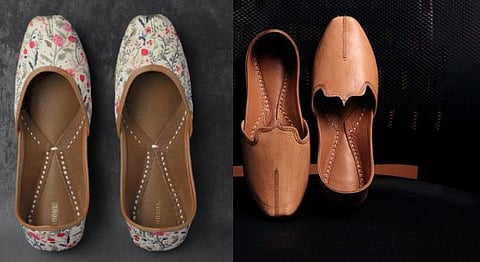
- HOMEGROWN WORLD
- #HGCREATORS
- #HGEXPLORE
- #HGVOICES
- #HGSHOP
- CAREERS
- ABOUT US
- CONTACT US

Historically, footwear had been a symbol of status or rank within a social structure, besides its most obvious function of serving as the means of protecting the feet. Footwear might also indicate a person’s personality, interest and choice. Even though footwear is mostly made of leather, in previous times, it was not so. Since ancient times leather footwear was forbidden in India because the Hindus consider cows as sacred. They were therefore mostly made of wood, plant fibre, and metals. However, Indian footwear have evolved over the years, and eventually engendered some of the most beautiful pieces of creations over the years.
Here’s a list of some of the most popular types of authentic Indian shoes in the market.
Mughal history has been a significant part of the narrative of the civilization of the Indian subcontinent that goes way back to 3300 B.C. It was the crux around which developed a multitude of sculptures, as well as ornately constructed architectures. Their love of the arts also manifested into the kind of ornaments and footwear they wore.
The juttis were a kind of footwear created by the Mughals, and is presently common in north India and the neighbouring regions. Traditionally made up of leather, it has extensive embroidery in real gold and silver thread used by the Indian royalty. Embroidered in reds, greens, pinks and peaches, these are aesthetically made footwear which come in many variations according to regional tradition, period, and shoemaker. The making of “juttis” is a tedious task, involving a lot of different craftsmen. The “juttis” are given a modern touch by stylizing them with motifs and images, besides the traditional thread and bead work. It is the most versatile piece of footwear one can wear to weddings, religious occasions, as well as in parties and festivals.
Originating in the Kolhapur town of Maharashtra as early as the 13th century, Kolhapuri chappals are handmade leather footwear tanned by using vegetable dyes. The origin of Kolhapuri chappals goes back to 12th century when the king Bijjala and his Prime Minister, Basavanna, encouraged Kolhapuri chappal production in order to uplift the cobbler community. They were earlier known as Kapashi, Paytaan, Kachkadi, Bakkalnali and Pukari, indicating the villages they were made in. An interesting fact associated with the Kolhapuri is that, with the onset of the Hippie movement, they became a very popular footwear in the United States.
Traditionally made by artisans using tanned leather, the mojari is a style of handcrafted footwear originating in Rajasthan. The uppers are made of one piece of leather or textile embroidered and embellished with brass nails, cowry shells, mirrors, bells and ceramic beads. The bonding from the upper to the sole is done by cotton thread that is not only eco-friendly, but also enmeshes the leather fibres with great strength. The “mojari” is an embodiment of cultural diversity, local ethos and ethnicity. Most of the major craftsmen can be seen at the Hawamahal Bazaar making different parts of the mojari each in groups of about six to eight people.
Produced mainly in Multan, Rajasthan and Punjab, Multani Khussas are juttis with flat soles and no left-right distinctions between them. The Khussa is part of the cultural heritage of Multan, which is in present-day Pakistan, and is part of the larger Indian subcontinent. During the times of the kings and queens, these Khussas were made of real gold and silver threads, and decorated with special gems and pearls. The Sikh society generally preferred a type of khussa known as ‘Jodhpuri’. The famous Sikh leaders Ranjeet and Sher Singh are depicted in miniature paintings wearing khussas. The khussa is made entirely by hand from the curing of the leather to the cutting and sewing together of the insole, outsole, sole and vamp. Khussas traditionally have no heel — they are completely flat and tend to be very comfortable. The embroidery can be very intricate or the decorative element may be as simple as raised leather lines on the upper sole. There are craftsmen who have been making khussas for decades and is anticipated to continue.
If you enjoyed reading this article, we suggest you also read:
